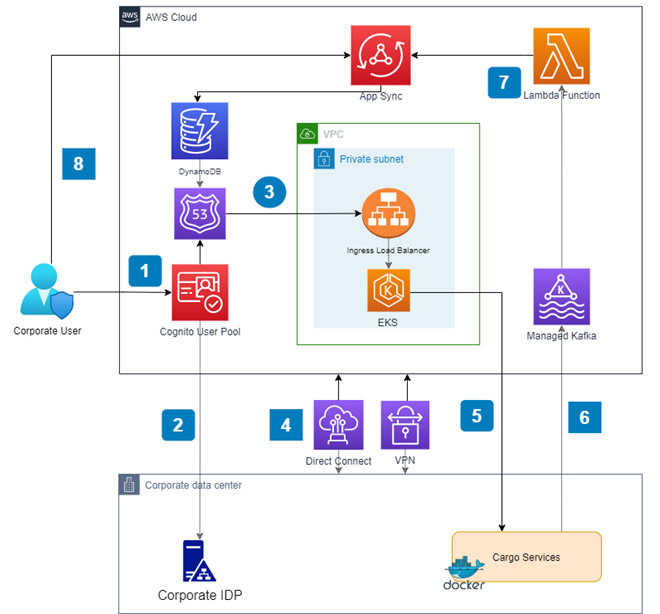Introduction
- August 9, 2022
To address this complex issue, TCG Digital followed a business-first, design thinking-based approach. The team conducted extensive field studies across 7 hub airports in the US, spending considerable time with ramp personnel and supervisors in the cargo department. They then proceeded with ideation, prototyping, and testing for a month to design a customer experience and lay new business processes. The team prioritized and customized requirements, rapidly built and deployed the final product with the most relevant features, and continually fine-tuned the solution through a feedback-based system.
The result? The Cargo Dashboard, a software product with a plethora of features that revolutionized the cargo department’s operations with the following features:
- Scanner apps to scan cargo items and maintain scan history
- Configurable scan points to let the business decide touch points across which they want cargo tracking
- Real-time monitoring
- Real-time alerts
- Rule-based engine
- Visual tracking
- Use responsive design for unified desktop and mobile experience
- Create, expose or consume micro-service based APIs
- Create real-time alerts in the application for user notifications
Latest Blog
Recent Posts
Managers who are tempted to feel elated at the prospect of having access to all the data they could ever wish for, soon realize it is a data sword of Damocles* hanging by a thread, ready to snap and bury them if they can’t find a way to unlock its value.

* The parable of the sword of Damocles teaches us that no matter how good someone’s life may appear, it’s difficult to be happy living under existential threat.
The architecture followed a loosely coupled approach, reducing single points of failure. Responsive visual design was used, and data was protected during both at rest and on transit by using modern encryption methods, such as HTTPS for data in transit and KMS for data at rest. Best practices of AWS cloud-specific principles were followed, including high availability of the solution with multi-availability zones and caching of resources where possible for a reduced load on computational resources.
Cargo Dashboard Architecture

- A corporate user of the dashboard logs in to the application. Cognito User Pool is used to present a login screen to the user where the user enters login credentials.
- Cognito connects with corporate Identity provider to authenticate users. The federation is achieved using a pre- configured trust relationship based on SAML assertions. On successful authentication, Cognito uses a callback Route 53 URL to redirect users to the dashboard landing page.
- Route 53 routes the request to an ingress load balancer deployed within a private subnet. The load balancer sits on top of a set of microservices deployed onto an EKS cluster. The front end is also containerized and deployed on EKS. S3 and Cloudfront were considered as an alternative for the front end. However, Cloudfront was not a whitelisted service at the organization and couldn’t be used.
- To establish a secure connection between AWS cloud and the corporate datacenter Direct Connect is used. An IPsec VPN tunnel is also configured and BGP routing is used to route traffic between cloud and datacenter.
- The microservices connect to corporate cargo services to fetch data for the dashboard. The corporate services essentially act as the backend for the microservices.
- The corporate cargo services generate some alerts to be displayed on the dashboard. These alert messages are pushed to a managed Kafka cluster on the cloud.
- A Lambda function is triggered that reads alert messages from Kafka and mutates those onto an AppSync API. AppSync uses DynamoDB as the backing datastore.
- The dashboard application subscribes to the AppSync API. After each mutation, the dashboard receives the new alert message. If a message is deleted from a dashboard the deletion gets mutated and is reflected in all open dashboards across devices. AppSync also takes care of offline synchronization.
In conclusion, TCG Digital’s business-first, design thinking-based approach enabled them to build a future-proof solution that met the client’s needs. The Cargo dashboard proved to be highly beneficial for the airline as it led to significant improvements in the efficiency and effectiveness of their cargo operations, enabling them to reach new heights.
[email-download download_id=”9583″ contact_form_id=”7713″]
[email-download download_id=”9446″ contact_form_id=”7713″]
Error: Contact form not found.
Watch the mcube video
The retailer client wanted a data-driven scientific approach to unlock business potential. This platform would take into account multiple predefined business dimensions to enable its reporting and business KPI dashboard and unlock answers for critical business questions via deployment of analytics solutions on a single platform tcg mcube. With Artificial Intelligence and Machine Learning capabilities built in the platform, this project would lay the foundation of a powerful data science journey and create differentiated value.The retailer client wanted a data-driven scientific approach to unlock business potential. This platform would take into account multiple predefined business dimensions to enable its reporting and business KPI dashboard and unlock answers for critical business questions via deployment of analytics solutions on a single platform tcg mcube. With Artificial Intelligence and Machine Learning capabilities built in the platform, this project would lay the foundation of a powerful data science journey and create differentiated value.













